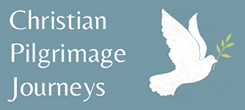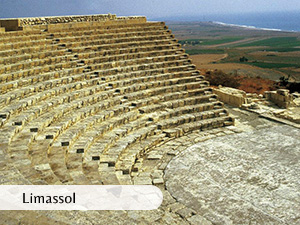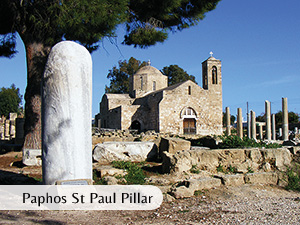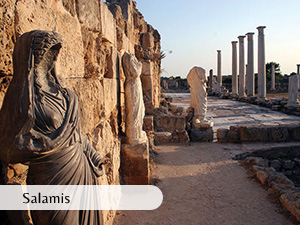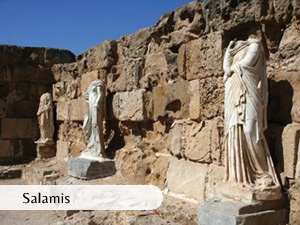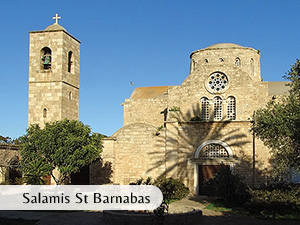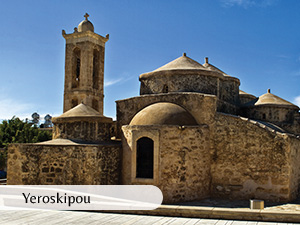
Cyprus / Culture & Pilgrim Tour
A 3 Days / 2 Nights Christian Tour In Cyprus
Itinerary
DAY 1: Arrival
Arrival at Larnaca or at Paphos airport and meet and assist by our staff at the airport. Transfer by a modern coach to a hotel in Limassol. Arrive at the hotel. Complimentary welcome drink will be offered by the hotel. Check in during the welcome drink. (provided we have early morning arrival – we can organize arrival/excursion on date of arrival, and do the check in in the afternoon) Excursion to the old city of Limassol, the surroundings and the vineyard area (depending on arrival time) After arrival, we drive to the center of Limassol. The Group will have the opportunity to walk through the old city up to the market. They will also walk by the medieval Fort, built in the 14th century on the site of an earlier Byzantine Castle. It was here that, according to tradition, Richard the Lionheart married Berengaria of Navarre and crowned her Queen of England in 1191.
We continue our trip driving through the Phassouri citrus plantations up to the Colossi Castle. We will visit the castle that is a fine example of military architecture, originally constructed in the 13th century and subsequently rebuilt in its present form in the 15th century. In 1291AD it served as the Grand Commandery of the Knights of St. John of Jerusalem. In the 14th century it came for a few years under the domain of the Knights Templar.
Closed to Colossi is the archaeological park of Curium. Curium was an important ancient city-kingdom founded by the Greeks in the 14th century BC. We will visit the Greco Roman Theatre and the House of Eustolios. The House of Eustolios originally was a private Roman villa that became a public recreation center during the early Christian period. It consists of a complex of baths and a number of rooms with beautiful 5th century AD mosaic floors.
Finally, we will visit the ruins of the Cat hedral of Curium, an early Christian basilica dated back to the 5th century. Attached to the north face of the basilica is the baptistery. After the visit, we will continue driving to the vineyard area of Limassol. We will arrive to one of the most beautiful and traditional villages of the island, the village of Omodos. We will have our lunch break at the Kafenion (coffee shop) of the village, where traditional dishes are served. After lunch, we will visit the Monastery of the Holy Cross at the village square and the medieval wine press. We will enjoy a wine tasting in one of the villagers’ wine cellar before we leave for Limassol. Dinner at the hotel.
DAY 2: Excursion to Paphos
Paphos is on the western coast of the island and is one of the most important archaeological regions of the island. The whole town is included in the official UNESCO list of cultural and natural treasures of the world heritage. Pafos is also important because of the religious history. St. Paul visited the town in the year 45AD accompanied by St. Barnabas. He was captured by the Romans and was flogged before the Roman Governor of Pafos Sergius Paulus who was later converted to Christianity.
We leave the hotel after breakfast and we arrive to “Petra tou Romiou”, the place, where according to the Greek mythology Aphrodite, the Goddess of beauty and love was born. After a short break, we will continue our drive to the village of Yeroskipou. In this village, we will visit the Byzantine Church Ayia Paraskevi, dating back to the 9th century. It is a basilica surmounted by five domes forming a cross and has beautiful mural paintings dating from the 9th to the 15th century. Free time will follow at the village square, where the group can visit the places, where the traditional sweet “Lokoumia” is produced or have a traditional Cyprus coffee at the village’s Kafenion.
Our journey continues after this break to Kato Pafos, where we will visit the Chrysopolitissa Church, built in the 13th century over the ruins of the largest Early Byzantine basilica on the island. Within the compound we will see the St. Paul’s Pillar, where St. Paul was flogged.
Before lunch break we will visit the Tombs of the Kings. Spread over a vast area these impressive underground tombs date back to the 4th century BC. They are carved out of solid rock with some being decorated with Doric Pillars.
After lunch, we will visit the archaeological park, where the House of Dionysos, the House of Aion and the House of Thysseus are. The mosaic floors of these noblemen’s villas dating back to the 3rd to the 5th century AD is considered among the finest in Eastern Mediterranean. Free time will be given at the fishing harbour and drive back to the hotel. Dinner at the hotel.
DAY 3: Excursion to Salamis, Famagusta & Larnaca
Famagusta is the city on the eastern coast of the island and it is still since 1974 under Turkish occupation. Next to Famagusta is the archaeological site of Salamis, the Birth Place of St. Barnabas. When St. Paul and St. Barnabas came to Cyprus in 45 AD they landed in the harbour of Salamis and then they cross the whole island passing by Kalopanayiotis in the Troodos Mountains and arriving to Pafos. The city of Famagusta is one of the most beautiful cities on the island. It is surrounded by the Venetian Walls. The city was very important during the Lusignan period on the island. After the Fall of Jerusalem to the Ottomans, Guy de Lusignan the King of Jerusalem came to Cyprus. His residence was in Famagusta, where he gave the order to build 365 churches, one for each day. Nowadays you can see the ruins of few of them and visit St. Nicola’s Cathedral.
We arrive to the check point at Strovilia to pass to the northern occupied part of the island. 10 minutes later we will arrive to Famagusta. We will visit the St. Nicola’s Cathedral, the Othello tower and will have free time in the old part of the city. We will drive to Salamis, the Birth Place of St. Barnabas, we will visit the ruins and then we will continue to the St. Barnabas Monastery where we will visit the Tomb of St. Barnabas.
Then we will drive to Larnaca for lunch. After lunch, we will visit at the center of Larnaca the St. Lazarus church built in the 9th century over the Tomb of St. Lazarus. According to the tradition and religious history St. Lazarus came to Cyprus after his resurrection and became the first bishop of Kition (ancient Larnaca). We will have free time at the Palm Trees Promenade of the town and we will continue our trip to Famagusta. Return to the hotel late afternoon / or to the airport
Biblical Readings
And when they were at Salamis, they preached the word of God in the synagogues of the Jews : and they had also John to their minister. And when they had gone through the isle unto Paphos, they found a certain sorcerer, a false prophet, a Jew, whose name was Barjesus: which was with the deputy of the country, Sergius Paulus, a prudent man ; who called for Barnabas and Saul, and desired to hear the word of God. Acts 13:5,6,7

